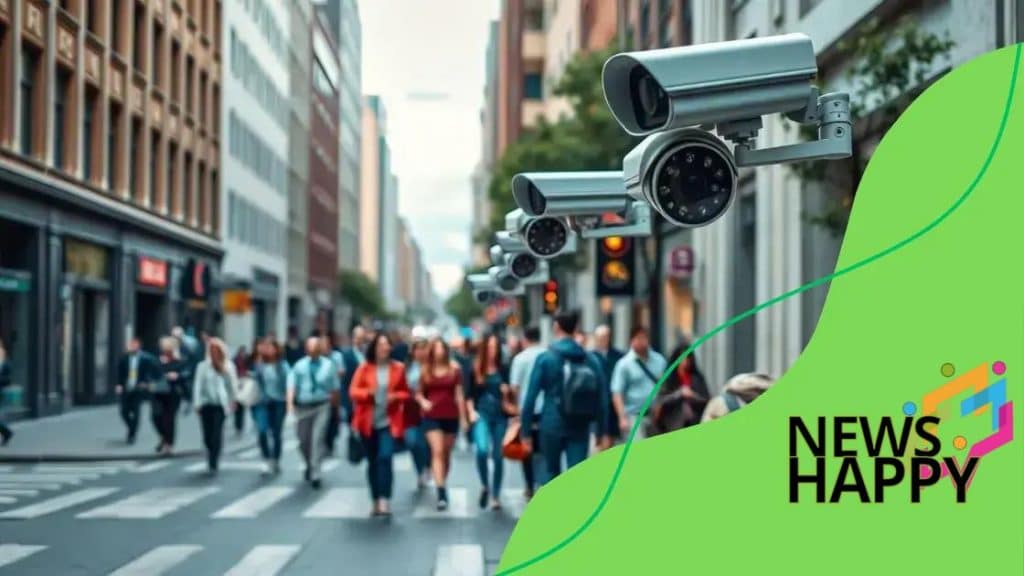The role of facial recognition in enhancing public safety

Anúncios
The role of facial recognition in enhancing public safety involves quick identification of suspects, improved emergency responses, and increased crime prevention, while also raising important privacy concerns that need to be addressed through regulation.
The role of facial recognition in enhancing public safety has sparked discussions worldwide. Have you ever considered how this technology might shape our everyday security measures? In this article, we’ll explore its benefits and implications.
Anúncios
Understanding facial recognition technology
Understanding facial recognition technology is essential in today’s world. This technology allows systems to identify or verify a person based on their facial features. As cities become smarter, facial recognition is playing a vital role in enhancing security and functionality.
How It Works
Facial recognition systems capture and analyze the features of a person’s face. Typically, they use various techniques, such as:
- Image acquisition from a camera
- Facial feature extraction
- Comparison with stored data
Once the features are extracted, they are converted into a mathematical representation. This representation is then compared to a database of known faces. If there is a match, the system identifies the individual.
Anúncios
Applications of Facial Recognition
This technology has numerous applications in public safety. For instance:
- Law enforcement agencies utilize it to identify suspects.
- Airports employ facial recognition for faster boarding processes.
- Security cameras can detect individuals on watchlists.
In addition to security, facial recognition technology enhances user experiences. Mobile devices now allow you to unlock your phone by simply looking at it. Businesses are also using facial recognition to improve customer service and engagement, allowing tailored experiences based on customer recognition.
How facial recognition improves emergency response
How facial recognition improves emergency response is a crucial topic in public safety. This technology helps first responders identify individuals quickly during emergencies. Swift identification can lead to faster resolutions in critical situations.
Real-Time Identification
During emergencies, every second counts. Facial recognition systems can scan crowds in public places like stadiums or airports to spot individuals who may pose a threat. By doing this, authorities can react promptly to potential dangers.
Case Studies
One notable example is how police departments use facial recognition technology during large events. For instance, at festivals or concerts, surveillance systems can alert law enforcement to known offenders. Such proactive measures enhance safety for all attendees.
In addition, facial recognition assists in tracking missing persons. When someone goes missing, the technology can help locate them in public spaces, aiding in their swift return.
Data Integration
The integration of facial recognition with existing emergency response systems can streamline operations. Emergency services can access real-time data from various sources, allowing for efficient resource allocation. This approach not only improves response times but also enhances situational awareness for responders on the ground.
The impact on crime prevention and investigation

The impact on crime prevention and investigation is profound with the use of facial recognition technology. This technology helps law enforcement agencies in various ways, including identifying suspects and enhancing public safety measures. By analyzing video footage and images, it assists in uncovering crucial evidence that can lead to arrests.
Identifying Suspects
Facial recognition systems allow police to identify suspects quickly and accurately. When an incident occurs, law enforcement can review surveillance footage to match faces against known databases. This speedy identification can result in:
- Faster apprehension of criminals
- Minimized time spent on investigations
- Increased public confidence in law enforcement
By improving identification processes, facial recognition reduces the burden on traditional investigative methods, allowing officers to focus on solving cases effectively.
Preventing Crime
Beyond investigations, facial recognition plays a significant role in preventing crime. By deploying this technology in public areas, police can deter potential offenders who know they are being monitored. When criminals realize that their faces can be captured and analyzed, they may think twice before committing a crime.
Additionally, high-profile events often use facial recognition to keep the peace. With the ability to identify individuals on watchlists, authorities can act preemptively to prevent incidents before they escalate.
Privacy concerns surrounding facial recognition
Privacy concerns surrounding facial recognition technology are significant and often debated. As this technology becomes more prevalent, individuals worry about how their personal information is collected and used. With facial recognition integrated into various systems, it raises essential questions about privacy rights and data security.
Data Collection
Facial recognition systems often rely on large datasets to function accurately. These databases can include images from social media, public surveillance cameras, and other sources. This extensive data collection leads to concerns about:
- How consent is obtained from individuals
- Who controls the data
- How long the data is stored
Many people aren’t aware that their faces can be recorded and analyzed, creating a sense of unease about being constantly monitored.
Potential for Misuse
The potential misuse of facial recognition technology is another significant concern. Law enforcement and government agencies may use this technology in ways that infringe on individual freedoms. Examples include:
- Unwarranted surveillance of citizens
- Targeting specific groups based on physical appearance
- Inaccurate identifications leading to wrongful arrests
These worries highlight the need for strict regulations to prevent abuse of facial recognition technology while safeguarding citizens’ rights.
Advocacy for Regulation
As a response to these concerns, advocacy for regulations on facial recognition is growing. Activists argue for transparent policies regarding how the technology is used. They emphasize the importance of:
- Establishing clear guidelines for law enforcement
- Ensuring public awareness of surveillance practices
- Implementing accountability measures for misuse
By promoting transparency and accountability, the public can feel more secure about the use of facial recognition technology in society.
Future trends in public safety technology
Future trends in public safety technology are evolving rapidly as technology advances. Innovations are being made to enhance security measures and improve community safety. The integration of new technologies promises to change how public safety agencies operate.
Artificial Intelligence Integration
One major trend is the increased use of artificial intelligence (AI). AI can analyze large amounts of data from various sources, making it easier for law enforcement to spot trends. This includes identifying crime hotspots and predicting potential threats. By utilizing AI, public safety agencies can allocate resources more effectively.
Smart City Initiatives
Another exciting development is the rise of smart city initiatives. Cities are implementing interconnected systems using sensors and cameras to improve public safety. These systems can:
- Monitor traffic patterns
- Enhance emergency response times
- Provide real-time updates during emergencies
With smart city technologies, officials can respond to incidents more quickly, ensuring community safety.
Wearable Technology
Wearable technology is also becoming more common for public safety professionals. Devices like smart badges and body cameras are now standard tools. These tools help officers capture important data during their routine duties. Wearable technology improves accountability and provides valuable information during investigations.
Public Engagement and Transparency
Moreover, many public safety agencies are focusing on enhancing public engagement. By utilizing apps and online platforms, citizens can report incidents or receive alerts. This two-way communication fosters trust between law enforcement and the community. Transparency in safety measures is crucial for a collaborative approach to crime prevention.
In conclusion, the role of facial recognition technology in enhancing public safety is significant and multifaceted. As we look to the future, advancements in this field promise to improve crime prevention and emergency response. However, it is essential to navigate the accompanying privacy concerns responsibly. With ongoing conversations about regulations and ethical use, communities can better embrace these technologies while ensuring individual rights are respected. By integrating innovative tools and maintaining transparency, public safety agencies can foster trust and collaboration with citizens for a safer environment.
FAQ – Frequently Asked Questions about Facial Recognition in Public Safety
How does facial recognition technology enhance public safety?
Facial recognition technology helps identify suspects quickly and improves emergency responses, making communities safer.
What are the privacy concerns related to facial recognition?
Privacy concerns include data collection without consent and potential misuse of information for surveillance, which could infringe on individual rights.
Are there regulations governing the use of facial recognition technology?
Yes, there are ongoing discussions about implementing regulations to ensure transparent and ethical use of facial recognition in public safety.
How can communities trust public safety agencies using facial recognition?
Transparency in how the technology is used, combined with open communication with the public, can help build trust between citizens and law enforcement.





